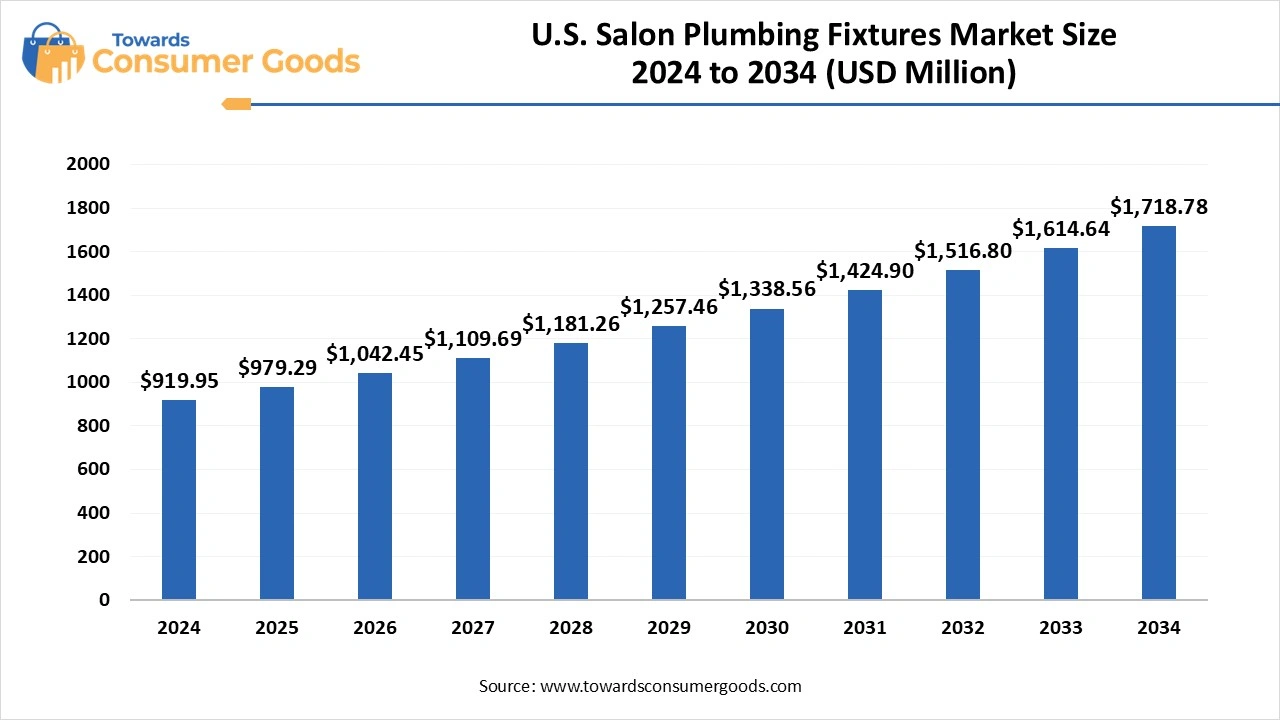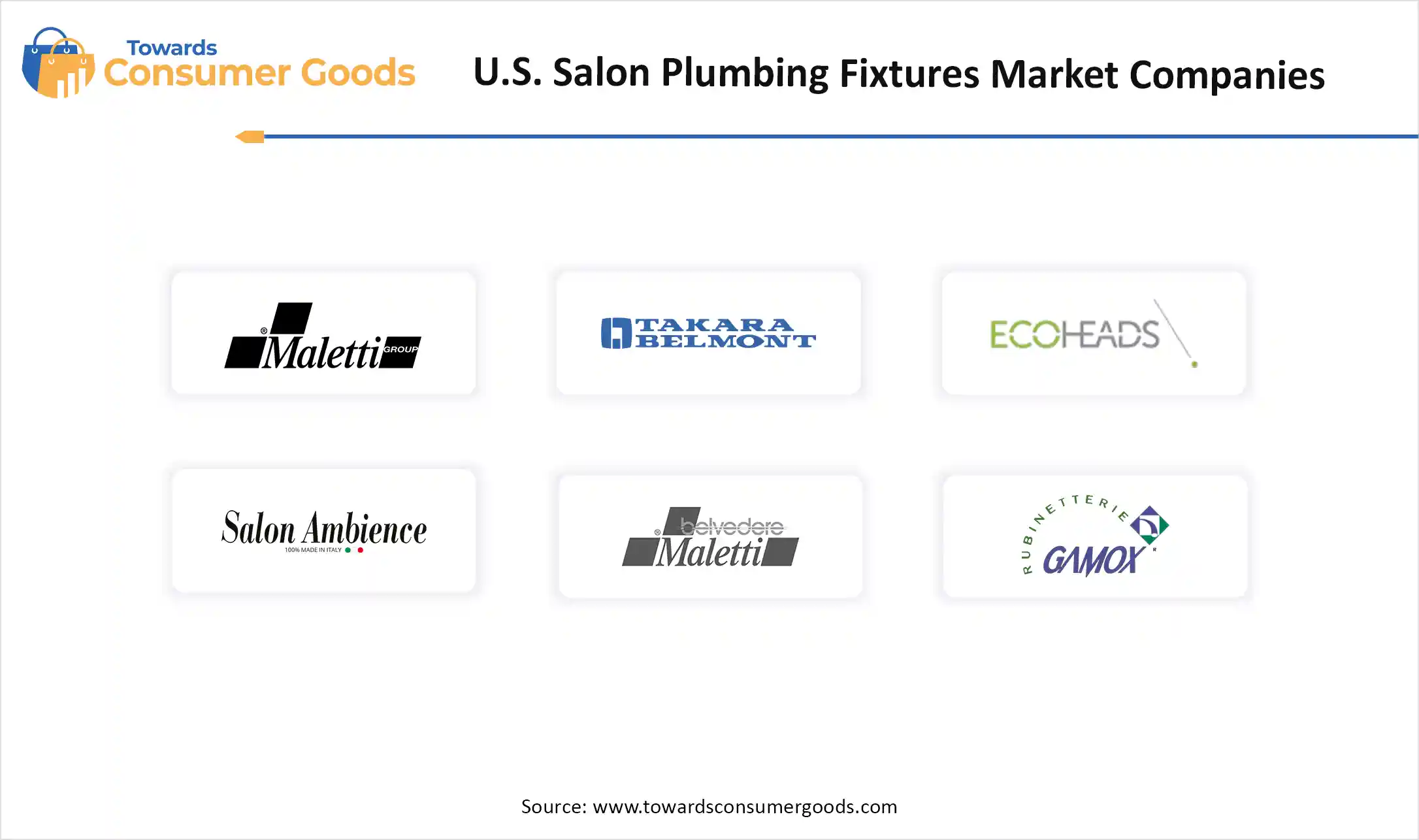July 2025
The U.S. salon plumbing fixtures market size was estimated at USD 919.95 million in 2024 and is predicted to increase from USD 979.29 million in 2025 to approximately USD 1,718.78 million by 2034, expanding at a CAGR of 6.45% from 2025 to 2034. The U.S. salon plumbing fixtures market plays a vital role in enhancing both the functionality and aesthetics of modern salon environments. From shampoo bowls to pedicure basins, the demand for ergonomically designed, durable, and water-efficient plumbing fixtures continues to grow in sync with evolving customer expectations and sustainability goals

In recent years, the U.S. salon plumbing fixtures market has experienced significant growth, primarily fueled by innovations in design and a rise in consumer expectations for premium salon experiences. Salons are increasingly prioritizing elements such as ambience, wellness, and sustainability, which are effectively reshaping the demand for plumbing fixtures that are not only efficient and ergonomic but also visually appealing. A notable trend within this sector is the high adoption rate of ceramic shampoo basins, water-saving faucets, and touchless technology, which serve to meet both state regulations and evolving customer preferences.
This drive for modern plumbing solutions is particularly pronounced among boutique salons and high-end chains, where infrastructure upgrades have become a core aspect of brand identity. Furthermore, retrofitting existing salons with contemporary plumbing systems is gaining traction, driven by a heightened awareness of water conservation and sustainability. The dynamic nature of this market is also heavily influenced by current interior design trends, positioning plumbing fixtures as essential functional components while also emerging as significant style statements.
Silhouettes, finishes, and overall aesthetics of these fixtures are now carefully curated to align with the overarching design narrative of salons, contributing to an elevated customer experience. The market also benefits from a renovation wave sweeping through older salons, aiming to modernize their interiors.
Upgrading to new-age wash units helps these establishments remain competitive in a highly saturated beauty industry. Notably, the long-term return on investment is a powerful driver for continued adoption. Although initial costs can range from moderate to high, the durability, multi-functionality, and low maintenance of modern wash units ensure value over time. For salons offering multiple services, such as hair coloring, scalp treatments, and spa washes, having high-end, adaptable wash stations is not just a convenience but a necessity.
Additionally, hygiene and health standards have evolved post-pandemic, pushing salons to adopt touchless operations and easy-clean surfaces. Many advanced wash units now come equipped with antimicrobial materials, sensor-controlled faucets, and auto-sanitizing systems to improve sanitation without increasing workload. Clients, too, are more aware than ever of cleanliness, making wash units that support these features more attractive. The growing preference for home-like yet high-tech environments further strengthens the wash unit’s place in modern salon culture.
| Report Attributes | Details |
| Market Size in 2025 | USD 979.29 Million |
| Expected Size by 2034 | USD 1,718.78 Million |
| Growth Rate from 2025 to 2034 | CAGR 6.45% |
| Base Year of Estimation | 2024 |
| Forecast Period | 2025 - 2034 |
| Segment Covered | By Product Type |
| Key Companies Profiled | Takara Belmont, Maletti Group, ECOHEADS North America, Belvedere Maletti, Salon Ambience, Gamox Rubinetterie S.r.l., Kaemark Inc., AgvGroup S.r.l., Collins, Minerva Beauty |
Tapping into experiential luxury and green innovation
The U.S. salon plumbing fixtures market is ripe with opportunity, driven by the growing consumer appetite for immersive, premium grooming experiences. As salons rebrand themselves as wellness retreats, there is a notable shift toward luxury-inspired plumbing elements, think sleek ceramic basins, matte-finish taps, and sensor-enabled faucets that deliver both style and sanitation. Simultaneously, sustainability has emerged as a core selling point, opening new ground for manufacturers offering water-saving technologies and eco-certified materials.
With millennials and Gen Z prioritizing aesthetics, hygiene, and social media–friendly interiors, there is robust potential for innovation in fixture design. Additionally, government incentives promoting green buildings and water conservation in commercial spaces further enhance market viability, especially for salons undergoing renovations or expanding into urban and suburban niches.
Blocked Pipes – Navigating Cost Barriers and Structural Constraints
Despite promising growth, the U.S. salon plumbing fixtures market faces notable restraints, primarily linked to the high installation and replacement costs of premium systems. Small and independent salon owners often find it financially burdensome to upgrade to high-end or smart plumbing fixtures, especially when retrofitting older infrastructure. Moreover, salons located in older buildings frequently encounter architectural limitations that restrict the installation of modern plumbing systems, requiring expensive custom modifications.
Maintenance and repair costs of advanced fixtures, particularly sensor-based and multifunctional ones, also pose challenges for long-term viability. Additionally, the shortage of skilled technicians trained in handling specialized salon plumbing setups can delay operations and deter potential investments. Collectively, these issues create a barrier to entry for smaller players and slow down market penetration in cost-sensitive regions.
Wash units continue to hold their position as the most dominant segment, and with good reason. These units are not just plumbing essentials; they are an integral part of the salon’s overall aesthetic, functionality, and client experience. A wash unit typically comprises a shampoo basin integrated with a supportive chair, ergonomic tilting mechanisms, and custom water controls, all of which together define the luxury and practicality of a modern salon visit. Salons across the country have come to regard these units as more than just functional pieces they are style statements and symbols of service quality. Whether in boutique hair studios or full-fledged wellness salons, a wash unit is often the first touchpoint where clients feel the comfort and professionalism of the service they are about to receive.
What makes these wash units so indispensable is their perfect balance of comfort, efficiency, and design. With customer experience being a high priority, features such as padded neck rests, reclining chairs, height-adjustable bowls, and warm water controls are no longer optional but essential. These user-friendly features reduce discomfort during longer treatments and allow stylists to work more efficiently without putting strain on their backs or arms. Ergonomics, therefore, plays a central role not only in client satisfaction but also in improving the work environment for staff. From a technical standpoint, many modern wash units are equipped with water-saving nozzles and eco-friendly taps that minimize consumption while maintaining flow, aligning with increasing sustainability goals. Furthermore, wash units are seeing innovations in both form and function.
Manufacturers have begun offering customization options that cater to salon branding from luxurious finishes in matte black and brushed bronze to modular add-ons like built-in towel racks, product trays, and digital temperature displays. The integration of these stylish yet practical enhancements allows salon owners to create a unique and visually cohesive space, attracting style-conscious millennials and Gen Z customers. In many cases, the installation of premium wash units directly contributes to increased revenue, as clients are more willing to pay for services when the salon environment exudes luxury and cleanliness.
On the other hand, handheld shower heads are fast rising as the most dynamic and rapidly growing segment, and their popularity is no accident. These compact yet highly functional devices have shifted from being basic attachments to high-tech, indispensable tools in professional salons. The growing trend towards flexible, personalized, and efficient water management in grooming services is positioning handheld shower heads as a game-changer in salon infrastructure. Their versatility allows stylists to rinse with pinpoint accuracy, apply treatments precisely, and reduce water wastage all while enhancing client comfort and stylist convenience.
The key advantage of handheld shower heads lies in their adaptability. Unlike fixed faucets or overhead rinsers, handheld models give stylists complete control over water flow, direction, and pressure. This makes them ideal for specialized services such as delicate scalp treatments, controlled hair dye rinses, or targeted deep-conditioning procedures. With multiple spray settings, pause features, and pressure adjustments, these devices cater to all hair types from curly and coarse to fine and sensitive without compromising service quality. This level of precision not only improves the effectiveness of treatments but also significantly enhances the client’s sense of being cared for.
Affordability is another driving force behind their accelerated growth. Handheld shower heads are relatively inexpensive compared to wash units and do not require extensive plumbing overhauls. This makes them a go-to solution for small and independent salons that want to upgrade their service quality without investing heavily. Even for larger salons, handheld units serve as smart add-ons that complement existing infrastructure. They are easy to install, easy to replace, and typically require minimal maintenance, offering both practical and economic advantages. In the post-pandemic landscape, hygiene has become non-negotiable. Handheld shower heads have responded to this demand with features like anti-bacterial coatings, easy-clean nozzles, and touchless operation options.
Some advanced models also include UV sterilization or self-cleaning mechanisms that prevent microbial buildup. By ensuring a more sanitary experience for each client, salons can build trust and reinforce their commitment to health and safety, an increasingly important factor in customer retention. From a stylist’s perspective, these devices reduce physical strain by offering better posture control and flexible operation. Stylists can easily manoeuvre the head around the client’s hairline, neck, and ears without having to bend awkwardly or stretch for fixed outlets. This has a positive impact on staff well-being and reduces the chances of repetitive stress injuries, a significant consideration in high-frequency service environments.

By Product type
July 2025
July 2025
July 2025
June 2025